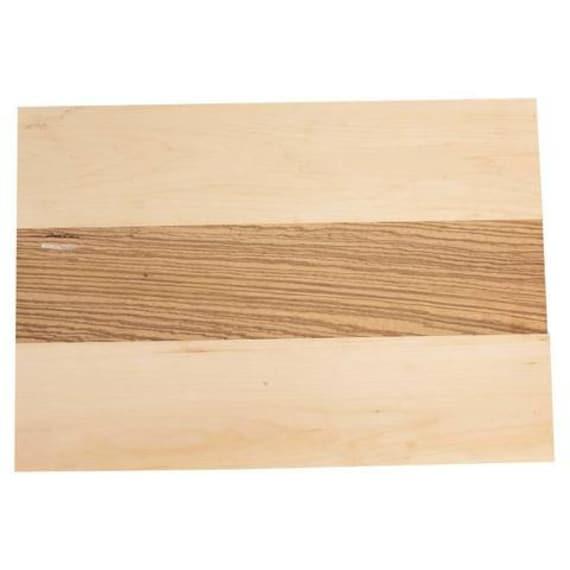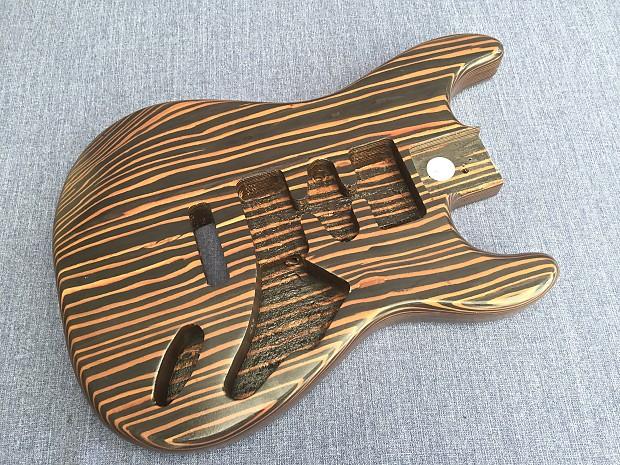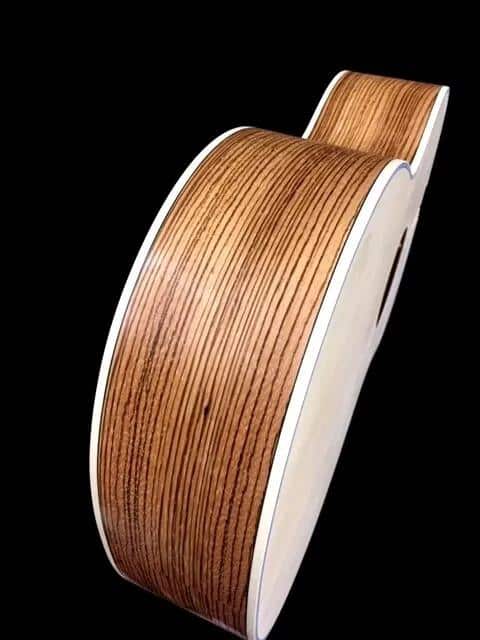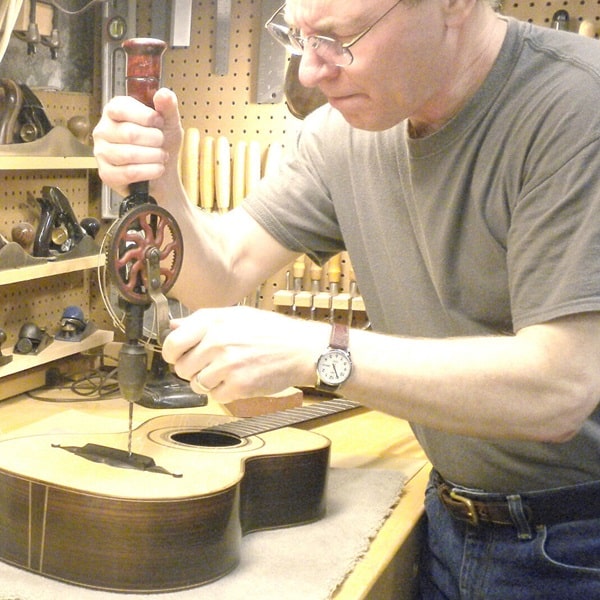Ready for a revolution in sound? Let me introduce you to the world of zebrano wood guitars. In the realm of guitar-making, the choice of wood can profoundly influence the tonality, resonance, and overall aesthetic of a finished instrument. As a seasoned luthier, I tip my hat to the uniqueness of zebrano wood – a remarkable material that has piqued my curiosity and tested my craftsmanship like no other.
You may be wondering, what on Earth is zebrano wood? Be patient, dear reader, as we’ll delve into that shortly. For now, picture the most sonically satisfying guitar you can imagine, its fretboard a masterpiece of grained beauty. Now, consider the possibility that this hypothetical guitar could be topped by the extraordinary patterns and tonal depth offered by zebrano wood.
With my two decades as a luthier, I’ve seen how this enchanting timber creates incredible, unmatchable guitars, rich in character and unmatched in projection. Herein lay a world waiting for exploration – the beautiful and lush universe of zebrano wood guitars.
Join me on this journey, as we explore the nitty-gritty details of the characteristics of zebrano wood, the physical properties that contribute to its distinctive sound, how it competes with other tonewoods, and dive into a detailed analysis of the tonal qualities of zebrano wood guitars. We’ll even look at some of the popular models and the varied constructions including, a solid body and semi-hollow, crafted from zebrano wood. As we travel together through this compendium of all things zebrano, I hope that you too, like me, will come to appreciate the allure, the versatility, and the sublime sonic qualities of zebrano wood guitars.
Characteristics of Zebrano Wood
Physical Properties

As we delve deeper into the heart of zebrano wood’s properties, two pivotal factors come into play: its density and its open grain. During my many years in lutherie, I’ve found these characteristics to be essential in defining an instrument’s tonality and durability.
The zebrano wood density is relatively high, averaging about 710 kg/m3. This is a step above many commonly used woods in guitar construction, such as Mahogany or Alder. The high density contributes to its durability and resilience against wear and tear – something I’ve come to appreciate in my craft.
Yet, it’s not just the density we should take note of. Another defining feature of zebrano wood is its open grain structure. This essentially means that its pores are large and distinct, similar to Oak. This open grain greatly affects the wood’s texture and aesthetic appeal, giving it beautiful visually alternating stripes of light and dark. Beyond the visual appeal, this openness also plays a role in the timber’s interaction with finishes and stains, often requiring a painstaking pre-finish process to achieve a smooth surface.
In my experience, these physical properties make zebrano an appealing choice among guitar builders. Its density gives it a unique resilience while its grain imbues the finished product with a striking, vibrant character that sets it apart from other guitar woods. It adds another layer of complexity to the craftsmanship of constructing Zebrano wood guitars, encouraging thoughtful and deliberate design decisions.
Blend these traits, and you have a type of timber that brings together the best of two worlds: a dense, robust body with an alluring and distinctive aesthetic. Understanding the physical properties of zebrano wood isn’t merely academic – it’s a gateway to appreciating the artistic value of Zebrano wood guitars, as we shall explore further in ‘Utilization in Guitar Components’.
Utilization in Guitar Components

As we transition from discussing the broad characteristics of zebrano wood, we now delve specifically into its utilization in guitar components, primarily focusing on its appropriateness for guitar necks. My work with diverse guitar elements has endowed me with a newfound appreciation for the adaptability of zebrano wood.
In the realm of guitar-making, zebrano wood for guitar necks stands out for its unique merits. This strong, dense wood offers a robustness that is vital for withstanding the demanding playability of a guitar neck. Over my years of guitar building, I’ve come to value the strength that zebrano wood offers, enabling it to tolerate high tension and prolonged use.
The eye-catching grain patterns inherent in zebrano wood, marked by its characteristic dark streaks against a light background, do not only serve an aesthetic purpose. The alternating hard and soft layers formed by these patterns increase its resistance to wear and tear. This makes zebrano wood an excellent choice for guitar necks that stand the test of time while also adding visual flare to an instrument.
Another noteworthy characteristic is its smooth texture. The hands of a musician appreciate the finesse of a zebrano wood neck’s touch, especially during fast, intricate passages of play. The texture of this wood provides a velvety touch, lending itself to a comfortable feel that facilitates effortless movement along the fretboard.
To conclude this section, it’s important to note that despite zebrano wood’s potency in guitar fabrication, it’s not about labeling one wood as superior to others. Instead, it’s about understanding how each contributes uniquely to a guitar’s tone, look, and feel. Looking ahead to the next section, we will compare zebrano with other woods used in guitar manufacturing, evaluating each for their distinctive traits.
Zebrano vs Other Woods

As we delve deeper into the chapter ‘Zebrano vs Other Woods’, let’s reflect back on the attributes of zebrano that we’ve already carved into detail in preceding chapters – its defining characteristics, physical properties, and utilization in guitar components. With that context freshly strummed in our minds, let’s venture into the territory that many fear to tread – comparing woods for building guitars. Matches that pitch Mahogany against Zebrano. These in-depth comparisons, steeped in my extensive experience, are poised to shed light on their significant impact on the overall sound and design of the instrument.
The question might have crossed your minds – ‘Why would you choose Zebrano wood over other popular types of wood for guitars?’ . A strategically apt place to unroll this intriguing standpoint. But, why Zebrano indeed? To those who have held a zebrano guitar in their hands, the answer likely resonates with your heartbeat. For others, we delve deeper into a zebra wood guitar comparison. Here’s where my lens tunes in on the intricate details that truly set zebrano apart.
Let’s start with a major contender – mahogany. In my experience, there’s a distinct tonal contrast when comparing Zebrano vs Mahogany guitars. Mahogany, often praised for its warm and balanced tone, falls short when compared to the sheer vibrance and unique timbre of zebrano. The latter offers a richer spectrum of tonal nuances, ranging from deep lows to crisp highs.
Additionally, zebrano stands out in terms of aesthetics. Each piece is uniquely veined with attractive dark streaks against a light background – thus earning its name ‘zebra’ wood. In contrast, while mahogany holds a classic and universally liked look, it lacks the distinctiveness that zebrano boasts in a humble yet bold manner.
In the realm of durability too, zebrano steps up the game. It’s a harder wood than mahogany, aptly reflecting in its strength and resistance to wear. It’s just the kind of wood you’d want your instrument to be comprised of – sturdy and enduring, yet gentle to the touch and a delight to the eyes.
These differences may seem marginal to some, while monumental to others. It’s the intricate matrix of these nuances that shapes your personal guitar journey. Throughout my guitar-building ventures, I’ve noted how different types of wood will resonate differently with each player. Like an esoteric whisper, they call out to the real enthusiast, softly shaping their sonic inclinations and aesthetic preferences.
As we tread along this fascinating journey marked with zebrano’s stripes, buying into each new nuance we uncover, let’s not lose sight of how this directly affects the tonality of zebrano guitars. In the following chapter, we’ll dissect ‘The Tonal Qualities of Zebrano Wood Guitars’ to better understand this intriguing instrument.
Tonal Qualities of Zebrano Wood Guitars

To speak of the tonal qualities of zebrawood, specifically in guitars, is to delve into a unique world of acoustics. In my years of studying instrument acoustics, the zebra wood tonal properties have emerged as distinctly captivating, interweaving multifaceted tones to create a breathtaking symphony, in perfect harmony with a player’s every stroke.
Do you ever wonder how the type of wood used in a guitar’s construction can dramatically alter its sound? Well, zebrawood is a prime example of this phenomenon, offering intriguing tonal qualities that are in stark contrast to many other woods I’ve had the chance to study.
There’s something enchantingly paradoxical about the zebrawood. It provides a strong, defined sound that cuts through, while still providing a rich depth and warmth. The zebrawood acoustic properties play a pivotal role in forming these distinct tonal attributes. Its high-density tends to reflect bright, lively treble frequencies, and its closed-pore nature gives a tangible resonance to the lower registers.
This results in a finely balanced tone; neither too bassy, nor too bright. Firmly held within these parameters, the tonality of the instrument is further enhanced by the wood’s unique resonance. The zebrano wood contributes to the sustain, the period for which the notes ring before they start decaying, and the tonal quality of a guitar. One would find that strumming a chord on a Zebrano guitar creates a smooth gestalt, a musical ensemble where the whole is more than the mere sum of its parts.
A Zebrano wood guitar takes your music to an elevated level, distinct yet harmonious. Nailing that specific tone you have been yearning for might not be as elusive as you think. The answer might be lying within the natural tonal architecture of the zebrano. Yes, it’s extravagant – a challenging essence to master, but when you do, it’s like you’ve hit the jackpot.
In retrospect, my fascination with the tonal qualities of zebrawood has grown in tandem with my understanding of it. It’s a dense and heavy wood, yes – but its rewards in tonality make it worth the weight. If you are craving a unique tonal flavour, a certain ‘je ne sais quoi’, that could elevate your sound above the crowd, I highly recommend you consider a zebrawood guitar. Its natural, nuanced tones might just be the fresh sound you’ve been waiting to discover.
The exploration of Zebrano wood and its effects on guitars is dense with insights, and it gets more fascinating with each dive into the realm. As we venture further, let’s keep in mind the tonal treasures tucked away within this wood, a bounty of potential that’s waiting to be awakened under skillful fingers on the Zebrano fretboard. As we continue to traverse down this exciting path in subsequent sections, let the majestic harmony of Zebrawood remain the leitmotif guiding us.
Popular Zebrano Wood Guitars
Solidbody Zebrano Guitars

Following our exploration of various popular zebrano wood guitars, I am delighted now to turn our attention to an instrument that holds an exceptional resonance with me personally – the solidbody zebrano guitar. As someone with a deep appreciation and knowledge of guitars, the combination of the solidbody design and the exquisite zebrano wood strikes a particularly captivating chord with me.
Solidbody guitars have a special place in my heart thanks to their solid construction, inherent resonance, and their ability to minimize feedback. Solidbody guitars exhibit a tendency toward a greater sustain, creating long-lasting tones that can bring a unique depth to your music. Pair this with the beautiful and distinctive zebrawood, and you have a guitar which is not just a remarkable work of craftsmanship but an exceptional performer.
Zebrano wood, with its visually striking appearance and superior tonal quality, complements the solidbody design beautifully. This blend of aesthetic appeal and acoustic excellence can impress even the most discerning of guitar enthusiasts. The unique grain patterns of the zebrawood, which range from tight and uniform to wildly wavy, give each solidbody zebrano guitar a unique personality. This is not merely about it looking stylish and intriguing in your hands; this is about a guitar that truly stands apart in the crowd.
Moreover, the tonal qualities of this strong, dense wood align harmoniously with the solidbody design, offering balanced sound with a vibrant resonance. The density and hardness of zebrano wood contribute to a bright, clear tone, a characteristic treasured by many guitarists worldwide and ideally suited to the solidity provided by the solidbody guitar.
In conclusion, among all other zebrano guitars, it’s the solidbody zebrano guitar that holds a special allure for me. Each solidbody zebrano guitar is truly one-of-a-kind, offering every musician a unique tonal palette from which to craft their sound. However, as any seasoned guitarist will agree – the journey of exploring the world of guitars does not stop here.
Next, we will travel towards the charming world of semi-hollow zebrawood guitars to further our insights into the diverse contributions of zebrano wood in the world of guitars.
Semi-hollow Zebrawood Guitars

Turning to the topic of semi-hollow zebrawood guitars, it’s noteworthy how this subcategory has contributed significantly to the popularity of zebrano wood guitars. In my experience, I’ve found semi-hollow guitars, especially when constructed with zebrano wood, have a unique tonal richness that is both balanced and enchanting.
Semi-hollow zebrawood guitars traverse the dynamic space between solid bodied and hollow guitars. They strike a unique balance that incorporates the resonance of hollow-bodied guitars without sacrificing the sustainability of solid-bodied ones. The semi-hollow design, coupled with the tonal qualities inherent in zebrano wood, produces a guitar that possesses depth and nuance, and is also comfortable to play.
The design features of semi-hollow zebrawood guitars offer the practicality of diminished feedback (a common issue with fully hollow instruments) and compensates with a remarkable sustain that distinguishes it in the family of zebrano wood guitars. The aesthetic appeal of the natural zebrawood grain is, of course, a bonus which adds to the overall charm of these instruments.
I’ve also noticed that the quartersawn pattern, often employed in crafting these semi-hollow zebrawood guitars, amplifies the distinct sound they deliver. It’s a realization that dawned upon me while comparing them to their solidbody counterparts. My interplay with these semi-hollow instruments has indeed added a touch of tonal transcendence that overflows into my compositions and performances.
The strong role of semi-hollow zebrawood guitars in the broader category of zebrano wood guitars cannot be overlooked. Whether you’re a budding musician or a seasoned professional, these guitars will offer you a distinct voice amidst the chorus of more standard guitar woods. If you go a step further and consider building one for yourself, know that you would be adding a significant chapter to the enduring tale of zebrano wood guitars.
We now transition from considering popular zebrano guitars to the exciting universe of crafting guitars from zebrawood. Here’s where your creativity can truly take flight.
Building Guitars with Zebrano Wood

As a seasoned luthier, I have tried my hand at many wood varieties when building guitars. From my experience, zebrano wood, with its striking appearance, and high resonance, stands out. I’m here to share with you some insights gained during my journey with this fascinating wood. I can assure you that with a little patience and diligence, you’ll find the zebrawood guitar building process quite rewarding.
Ever considered building your own guitar? Let zebrano wood make your endeavor even more satisfying. The process begins with picking the right raw materials. That’s where zebrawood guitar kits come in handy. These kits provide all the necessary ingredients for your custom piece, including pre-cut, and contoured zebrano wood that you can shape and sand to your liking. They save you the challenge of procuring and processing the raw wood, which can be a huge time saver, especially if you’re just getting started.
One of the first things you’ll note with zebrano wood is that it’s quite strong and dense, meaning it retains shape well and responds beautifully to carving. That’s a trait I, as a luthier, truly appreciate. However, it’s worth noting that due to its density, zebrano can be a little more challenging to work with compared to softer woods like mahogany. Don’t be deterred though. With a bit of perseverance, you’ll find that zebrano is incredibly satisfying to shape and carve, yielding a unique visual appeal courtesy of its eye-catching grain patterns.
Among the main components to be crafted from the zebrano wood include the guitar body, neck, and sometime the fretboard. Each presents unique opportunities and challenges. Crafting the body requires precision carving to shape the electric guitar’s contours, ensuring proper balance while optimizing for acoustic properties. Here, zebrano shines- its hardness lends itself well to creating a solid, resonant body capable of delivering rich, warm tones.
The neck of a guitar constructed from zebrano has a couple of advantages. First, its strength provides stability, a crucial factor considering the substantial tension that guitar strings exert. Second, the aesthetically pleasing striped appearance of zebrano wood offers a noticeable distinction, making the neck a unique, complementing feature of the guitar.
Creating the fretboard from zebrano is a bit rare but it offers a remarkable playing surface. A fretboard made of zebrano offers a smooth, hard surface for the strings to strike. This creates a distinctive playing character and tone, which sets your guitar apart.
One thing for certain is that a zebra wood guitar building project isn’t just a chance to create a beautiful instrument, but also to learn and grow as a luthier. Designing and crafting a guitar from zebrano wood pushes your skills to the limit. The process demands patience, precision, and a keen eye for detail. It’s a labor of love and a testimony to your passion for music.
Beyond the allure of creating something unique with your own two hands, working with zebrano wood teaches you something truly significant – that with the right material and attitude, anything is possible in guitar building. Zebrano wood is indeed a canvas that espouses creativity, passion and resilience in every guitar maker who dares to venture. So, next time you consider building your own guitar, remember – zebrano wood could make your endeavor even more satisfying and rewarding.
FAQs
What is Zebrano Wood?
Why is Zebrawood used for guitars?
How to maintain Zebrawood guitars?
Where can I buy Zebrawood guitars?
Conclusion
In my twenty-plus years of guitar crafting, I’ve found zebrano wood to be a truly unique and highly rewarding material to work with. The striking patterns and resonance of this exotic wood make each zebrano wood guitar a distinctive piece of artistry.
What makes zebrano wood guitars a worthy addition to a musician’s collection? An in-depth zebra wood guitar comparison reveals that their tonal qualities stand apart, offering a richness and warmth that is unparalleled. A musician’s expression finds a unique voice in the depth and balance of these guitars, whether its a solidbody or a semi-hollow instrument.
For those looking for something smaller, the zebrano ukulele offers the same unique aesthetic and tonal dynamics with the charm of the compact instrument. Whether you’re a seasoned guitarist or a ukulele enthusiast, these handcrafted instruments offer a unique balance of aesthetics, tonality, and playability.
Working with zebrano, like most exotic wood guitars, can be challenging, which makes every instrument a testament to the craft of lutherie. In fact, the characteristic patterns and physical properties of zebrano create a connection not just between the musician and instrument but also with nature.
In conclusion, there’s more to a zebrano wood guitar than meets the eye. Their visual appeal complements their tonal qualities, giving the musician a perfect combination of form and function. From my personal experience, there’s something truly special about playing and crafting zebrano wood instruments – a delight I hope every musician may experience.

R.M. Mottola, an engineer-turned-luthier, revolutionizes stringed instrument design with his deep focus on acoustics and ergonomics since 1994. As editor of the Savart Journal and a key contributor to American Lutherie, Mottola merges science with artistry in lutherie. He enriches the field with his extensive knowledge, shared through his Liutaio Mottola website, making him a beacon in the world of modern instrument craftsmanship.
